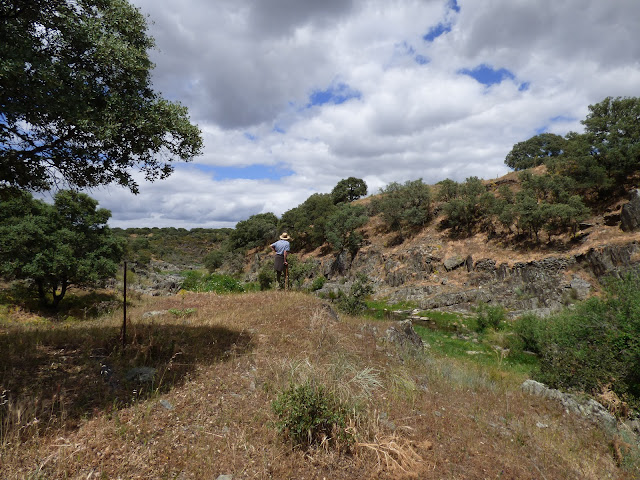News from Finca al-manzil, Extremadura. Accommodation. Life on the finca, local trips and longer voyages
Showing posts with label Sierra de Montanchez. Show all posts
Showing posts with label Sierra de Montanchez. Show all posts
Monday 22 April 2019
From Finca al-manzil to Montanchez via Garganta de Molinos
One of our favourite hikes, about 12 kms, takes about 3 hours over very varied terrain, a steep climb up the garganta but then fairly level through chestnut woods into Montanchez and then downhill back to the finca.
Monday 11 February 2019
Hoop petticoat daffodil, Narcissus bulbocodium
Sunday 23 December 2018
Winter walk to La Preciosa
One of our favourite walks from Montanchez village to Manfred's olive grove, La Preciosa. It's about 3kms across the sierra on a high slope looking down on Arroyomolinos. It feels like the end of the world, perfect peace and beautiful views. The olive grove is ancient with wonderfully knarled olive trees and a few old fig trees, surrounded by intricately layed stone walls, it's a special refuge and often our picnic spot.
Today the clouds were lying low in the valleys but up above the sun was really bright and warm, the sky a gorgeous luminous blue.
Today the clouds were lying low in the valleys but up above the sun was really bright and warm, the sky a gorgeous luminous blue.
Sunday 28 October 2018
Battle of Arroyomolions re-enactment on October 28
A different format this year, somewhat reduced with no horse activity unfortunately but entertaining never the less. A perfect autumn day with blue skies above Arroyomolinos unlike the original battle of 1811 when there was torrential rain and thunder storms.
See here for the 200 year anniversary in 2011
http://finca-al-manzil.blogspot.com/2011/10/battle-of-arroyomolinos-200-year.html
And here for some spectacular horse action
http://finca-al-manzil.blogspot.com/2013/10/a-beautiful-day-for-anniversary-of.html
See here for the 200 year anniversary in 2011
http://finca-al-manzil.blogspot.com/2011/10/battle-of-arroyomolinos-200-year.html
And here for some spectacular horse action
http://finca-al-manzil.blogspot.com/2013/10/a-beautiful-day-for-anniversary-of.html
Wednesday 10 May 2017
Botija and walk to Villaviejas, a Celtic -Iberian archaeological site
Coming back from Trujillo we took a route near La Cumbre. There is a road with an extensive project to provide nest boxes on every telephone post, many of them were occupied by the beautiful European Roller, my first sighting of this bird, astounded by the gorgeous plumage.
Arriving in Botija we wanted to do a new walk, a continuation from the mill buildings on the River Tamuja, along the river bank to Villaviejas, the remains of a Celtic Iberian village of the Vettone tribe, circa 200 -50 B.C.
Before the walk we strolled around the village, on first sight nothing special but there were many points of interest.
The Church of Santa Maria Magalena is a simple rustic structure from the XV1 century but it has charm and gives some great perspectives from the surrounding olive groves.
The Vettones were a pre-roman Celtic Iberic tribe covering an area between Salamanca, Alcantara and Toledo with Villaviejas being the most southerly settlement. They were active for about 400 years before the Romans gradually making more established and populous settlements. With the coming of the romans the remote rural settlements survived for a time but were gradually absorbed into the roman organization of their new colony Lusitania with Merida as the capital.
For very detailed and interesting information about the Vettones and their mode of life, read on here-
https://www4.uwm.edu/celtic/ekeltoi/volumes/vol6/6_5/alvarez_sanchis_6_5.html
Arriving in Botija we wanted to do a new walk, a continuation from the mill buildings on the River Tamuja, along the river bank to Villaviejas, the remains of a Celtic Iberian village of the Vettone tribe, circa 200 -50 B.C.
Before the walk we strolled around the village, on first sight nothing special but there were many points of interest.
The Church of Santa Maria Magalena is a simple rustic structure from the XV1 century but it has charm and gives some great perspectives from the surrounding olive groves.
The village is built from the surrounding stone, slate. On the more humble buildings it is left exposed, unplastered. The wonderful craftmanship of laying the stone is exposed, intricate and fascinating.
Paths between slate walls lead out of the village into the surrounding olive groves and pastures. On the edge of the village is a fascinating ruin, an old fabrica de aceites, not sure if this means an almazara, olive oil mill or not, needs further investigation. A little world of its own, behind the 3 metre surrounding walls were a courtyard, lots of barns and a secret garden.
The walk to the molinos is one of our favourites and is described here.
Today we started off on new territory beyond the molinos on the path to Villaviejas.
We walked for 25 minutes on a footpath which wound along the meandering Tamuja sometimes leaving the riverbank where the rocks were too steep.
It is not really obvious when arriving at the site of Villaviejas, it is on a bend of the river, on the opposite bank and relatively high above a natural slate embankment, a good defensive position.
It is easy to cross the river at this time of the year, plenty of exposed rocks to use as stepping stones.
The Vettones were a pre-roman Celtic Iberic tribe covering an area between Salamanca, Alcantara and Toledo with Villaviejas being the most southerly settlement. They were active for about 400 years before the Romans gradually making more established and populous settlements. With the coming of the romans the remote rural settlements survived for a time but were gradually absorbed into the roman organization of their new colony Lusitania with Merida as the capital.
For very detailed and interesting information about the Vettones and their mode of life, read on here-
https://www4.uwm.edu/celtic/ekeltoi/volumes/vol6/6_5/alvarez_sanchis_6_5.html
Subscribe to:
Posts (Atom)























































